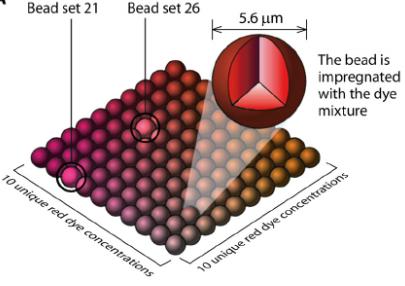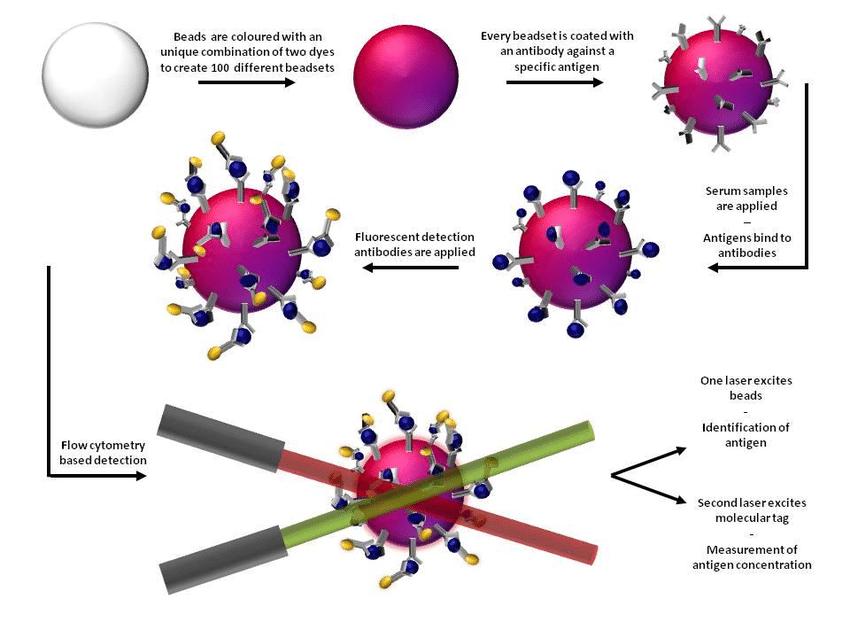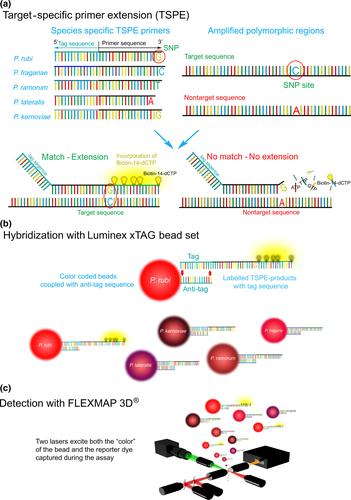Multi-analyte profiling (xMAP) technology is a high throughput, high speed and versatile molecular diagnostic platform developed by Luminex, Inc. The technology integrates fluorescence-encoded microspheres, laser detection, flow cytometry, high-speed digital signal processing technology and computer algorithms. It uses different fluorescence-encoded microspheres as reaction and signal detection carriers and flow cytometry as optical detection means to achieve multiplex detection of proteins, nucleic acids and other biological macromolecules in liquid-phase reaction systems. The three multiplexers Magpix, Luminex 200 /100 and Flexmap 3D are based on xMAP technology, which can bring high throughput and fast and accurate analysis results.
Encoded Microspheres
Encoded microspheres are polystyrene microspheres labeled with different fluorescent dyes. The diameter of microspheres is usually 5.6 µm. There are five main types of microspheres: MicroPlex microspheres, SeroMap microspheres, LumAvidin microspheres, Mag-Plex microspheres and MagPlex...xTAG microspheres.

The principles of the five types of microspheres are basically the same. The latter 4 are developed from MicroPlex microspheres.
SeroMap microspheres are used to reduce the non-specific binding of different antibodies to microspheres in serological assays.
LumAvidin microspheres are suitable for the detection of small molecules.
MagPlex microspheres (magnetic beads) are based on MicroPlex microspheres with a ferrite layer of 6.5 um. They are magnetic and can be used for sample processing using a magnetic holder or a magnetic plate washer, making instrument operation simple and convenient and making it easier to obtain stable results.
MagPlex-xTAG microspheres are pre-linked with xTAG nucleic acid probes on the magnetic surface and are optimized for temperature homogeneity and minimal cross-reactivity for nucleic acid detection.
xMAP Technology
The xMAP technology combines flow cytometry, enzyme-linked immunosorbent assay (ELISA) and microarray technology. The core is to dye polystyrene microspheres with different ratios of red and orange fluorescent dyes to different concentration gradients of fluorescent colors, respectively, resulting in up to 100 fluorescent-encoded microspheres. With the addition of a third dye, the number of extinction-encoded microspheres can be expanded to 500. The fluorescence-encoded microspheres are then covalently cross-linked with probes, antigens or antibodies targeting specific detectors.
Fluorescence-encoded microspheres targeting different assays are mixed, and then a tiny amount of the sample to be tested or its polymerase chain reaction (PCR) amplified fragment is added. The target molecules in the suspension bind specifically to the capture molecules cross-linked on the surface of the microspheres and the conjugate is labeled with the fluorescent material. The microspheres are passed sequentially through the red and green laser beams in a single line by the sheath delivery system. The red laser excites the fluorescence of the microspheres themselves and is used to identify the type of microsphere. The green laser excites the fluorescence of the bound reporter molecules, and the intensity of the fluorescence is detected to quantify the substance under test.
The Magpix bead multi-detection system is used to bring the beads to be measured into the dark chamber cavity with less sheath fluid and form a single layer of beads that are captured by the bead collection plate. A classification and detection light-emitting diode (LED) source is focused on the captured beads in the dark chamber cavity to excite the microsphere fluorescence coding signal and the reporter fluorescence signal, respectively. The beads are then imaged by a high-sensitivity charge-coupled device (CCD) and the beads are classified and detected by software with specific algorithms.
 Overview of Luminex xMAP technology used to quantify serum concentration of proteins and small molecules (Ramsey et al., 2015).
Overview of Luminex xMAP technology used to quantify serum concentration of proteins and small molecules (Ramsey et al., 2015).
xTAG Technology
The xTAG technology uses Luminex proprietary universal tags to optimize nucleic acid experiments through specific complementary pairing of tag sequences with anti-tag sequences. xTAG technology ensures the same complexation temperature while effectively avoiding cross-hybridization.
The principle of xTAG technology is to amplify the nucleic acid to be tested by PCR and the amplified DNA is mixed with short sequence TAG primers. If the target is present, a target-specific primer extension occurs and a marker is simultaneously incorporated. Microspheres linked to the anti-TAG sequence are added to specifically identify the target primer by complementary pairing. The microspheres are driven through the red and green lasers in a single sequence by the flowing sheath fluid, and the data obtained are processed by the computer and analyzed by the software to determine the results.
 Schematic representation of the multiplex assay for detection and identification of Phytophthora species in three major steps (Kostov et al., 2016).
Schematic representation of the multiplex assay for detection and identification of Phytophthora species in three major steps (Kostov et al., 2016).
Creative Proteomics provides Luminex multiplex assay technology, allowing a selection of over 1200 metrics across 8 species, covering popular research areas such as oncology, immune diseases, metabolic diseases, cardiovascular diseases, neurodegenerative diseases, nephrotoxicity, stem cells, signal transduction pathway studies, and more.
References:
- Ramsey, J. M. (2015). Central and peripheral molecular profiling of sex differences in schizophrenia, major depressive disorder, and controls (Doctoral dissertation, University of Cambridge).
- Kostov, K., Verstappen, E. C. P., et al. (2016). Multiplex detection and identification of Phytophthora spp. using target‐specific primer extension and Luminex xTAG technology. Plant Pathology, 65(6), 1008-1021.



